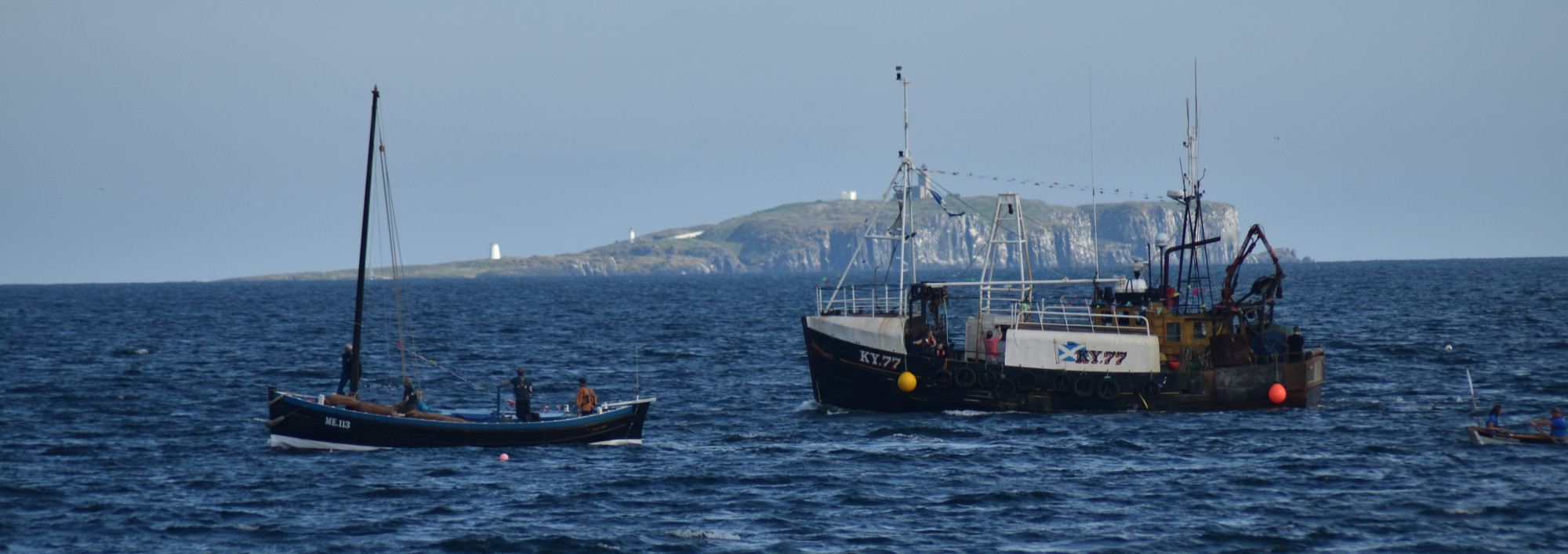1869
(It was in 1869 that the new KY registrations became compulsory to be marked on the hulls and the sails of the vessels.)
On Friday last the cruiser Vigilant of the Fishery Board Service detained several fishing boats and yawls belonging to Cellardyke, Pittenweem and St Monance, in consequence of their sails not being numbered according to the requirements of the Fishery Act of 1868. The Hon F B Primrose, the secretary of the board and Captain Macdonald, landed from the cruiser, and in company with Mr Gillis the Fishery Officer here had some conversation with our local fishermen here on the subject of the new law numbering their boats and sails. It was represented, to Mr Primrose, that painting the number on the sail had a tendency to injure the canvas; but Mr Primrose pointed out that was entirely a mistake, although it was quite true that if turpentine was used the sail would be more or less destroyed, but if white lead an oil only were employed, then instead of damaging it the paint would have the effect of strengthening and preserving the sail. Mr Primrose also intimated that in the event of any fishing boat being found at sea by the cruiser without a sail being numbered the full penalty – namely a fine of £20 each upon the master and owner of the boat, would be imposed, and that after Monday no boat would be allowed to leave the harbour unless the regulation was complied with. In reference to this matter, we may state that all the deep sea and other fishing boats, down to the smallest lobster yawl on this coast were duly numbered and registered by the 1st April, the appointed date, and we learn that the regulation as to numbering the sail is now equally observed.
1870
Sea labour has this week shown signs of a gratifying improvement. The strong East winds have enabled the deep sea boats to reach the mist distant fishing grounds, and how well they have adventured may appear in the fact that the largest of the Cellardyke fleet, under all sail, was 24 hours on the passage home, which would give a distance of 150 to 200 miles from the May. This week most of the 40 boats fishing from Cellardyke have been at the great line fishing, at which the takes have ranged from £8 to £22, but last week the fleet was at the haddock fishing, when the boats returned on Friday with a total catch of 30 tons, the takes being from 51/2 to 22 cwt, which sold from 6s to 12s per cwt.. This week two Cellardyke boats have left for the Herring Fishing at Barra. Two St Monance boats are succeeding moderately well at the Tiree cod fishing and at the Salmon Fishing on the Northumberland Coast, at which several Buckhaven and St Monance and one Cellardyke yawl are at present engaged, the success is reported to be far less encouraging than in former years.
1871
St Andrews – For some time back a regular warfare has been going on between the St Andrews fishermen and the parties authorised by the town council to sell the mussels at the scalps of the south side of the Eden, a good quantity of mussels have been taken away by the fishermen without being paid for, though it is said they offered 6d instead of 1s the basket, and on the refusal of this sum ‘helped themselves”. We believe a number of them will appear in Cupar Sheriff Court on the charge of theft… While we would not defend their conduct in all they have done, this is not to be wondered at, if we take into account the loss of time through rough weather they have had this last winter, and remember that in addition to the 1s charge for mussels, 2d is charged for cartage. When the fisherman has no wife he has to pay 1s for baiting the lines, making it 2s 2d of an outlay before the line is put into the boat at all. We know it is urged that boats from Cellardyke are able to pay the 1s; but then it must be remembered that these are large boats, and the mussels are only got for the purpose of catching other bait for the deep sea fishing; consequently they only bait once a week, while our fishermen require it daily.
David Brown who was convicted on Saturday in Cellardyke Court of committing breach of the peace and malicious mischief (found guilty and fined 10s 6d or 10 days) appeared before the Burgh Court of West Anstruther, he was charged with furious driving to the danger of the lives of the lieges on the High Street on the evening of Wednesday Last. He pleaded guilty and was convicted to a fine of 5s or eight days imprisonment.
1874
The Kilrenny School board met on Friday evening, Rev Christie presiding, A communication was read from Dr Taylor to the effect that the education board was of the opinion that, in order to make suitable accommodation for the parish, a new school to accommodate 200 pupils should be erected in Cellardyke. Mr Fortune Barnsmuir presented a memorial from the rate payers in the landward district of the parish, asking the board not to adopt this opinion on the ground there already existed the Accommodation required by the act, and stating that they would not pay any assessment for building a new School in Cellardyke. Provost Martin moved that the opinion of the education board be adopted, which was seconded by Rev Mr Grant. Mr Oliphant moved as an amendment that no additional school be built in Cellardyke on the grounds that it was Ultra vires of the board to assess the ratepayers for the expense. Mr Gray seconded the amendment, which was carried by a majority of four to three. The Minority protested and appealed to the education board.
1875
The fine farm house of Corn Ceres – the most picturesque homestead in the East Neuk- narrowly escaped being destroyed by fire. It appears that one of the chimney flues had taken fire, and that, all unperceived and unsuspected, the burning soot had lodged in the cavity of the double ridge till it had ignited the ‘tinder dry’ wooden grating overlying the gutter, which melting the lead, gave the flames ready access to the timber work of the roof. …… in a dense canopy of smoke and flame, veteran Cellardyke builder, Mr Andrew Duncan, ascended the roof and with all the vigour and agility of youth, stripped away the slates, when the flames being thus unbosomed to the copious stream of water, which resolute hands played upon them the fire was subdued just as the rafters had come within the devouring embrace.
Mrs Margaret Kay or Dishington, West Anstruther, for having a number of incorrect weights in her possession was fined a £2 penalty, James Bell, grocer from the same district received a similar sentence as did also William Black Watterston, baker , Cellardyke..
1876
One of the extraordinary incidents in the romance of the sea may well have been said to have occurred last week in the North Sea, in the capture of a formidable looking shark by the most primitive of all fishing implements – the hand line- It happened on board the deep sea going boat “Venus” skipper Peter Murray, just as the adventurous crew were wiling away and idle hour as they usually do at the fishing ground; but we ought to explain that the hand line of the sea is not a solitary hook of the coast, but a novel apparatus so terrible in appearance as to be not inappropriately named “a murderer” by our East of Fife Crews. But what is a murderer? Some curious reader may ask, and to solve any mystery, it may briefly be described as a long leaden plummet strung round with large hooks – in short, so barbed as to take a secure hold of anything or everything coming in contact with it. The apparatus is the more effectual that it is kept in constant motion in the same was as the ‘Jigs’ or dandy lines, only it is always made to strike the bottom, where it often proves a deadly snare to the cod, the halibut, and other deep sea fish, and that as readily without as with bait, provided lead and steel are kept silver like as possible, exactly on the same principle as the polished implement to catch young herrings. Such was the weapon in the fingers of the Cellardyke fisher, when in an instant the line seemed to become fast to an old wreck at the bottom – so dead and solid the weight. Friendly hands came to the rescue, and slowly and surely the gallant mariners raised the ponderous mass towards the surface. “What can it be?” asked one son of St Peter at another “ The sea serpent itself” observed a third, but if it had, the surprise of the crew should not have been more, when after a pull of over five and thirty fathoms from the bottom a tremendous shark arose alongside. Our sea heroes, however, were neither daunted nor in difficulties, but quickly applying boathooks and other serviceable weapons, they soon dispatched the monster, which was then hoisted into the boat and landed at Anstruther, where the extraordinary trophy excited no little attention and interest. It measured about eleven feet in length, and was fully eight in girth. While lying on the old pier it was purchased by Mr Thomas Cormack at the price of half a sovereign for the sake of the valuable oil yielded by the liver of the ‘scourge of the seas’.


